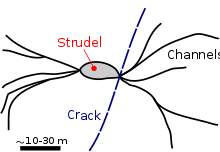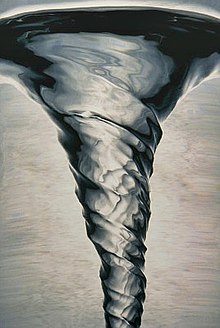Loading AI tools
Vertical hole in sea ice From Wikipedia, the free encyclopedia
A strudel /ˈstruːdəl/ (plural: strudel)[1][2] is a vertical hole in sea ice through which downward jet-like, buoyancy-driven drainage of flood water is thought to occur.[3][4][5] This feature is less than a few tens of meters in size and typically occurs within 30 km from a river mouth, in the sea ice expanse that is fastened to the coastline (known as fast ice).[3][5] Once the water that flooded the ice has completely drained off the ice surface, strudel become recognizable by a radial pattern of feeder channels that lead to the hole.[3][5][6] They are elongated and irregularly spaced, with the larger ones up to several kilometers apart. Their distribution tends to be controlled by weak areas in the ice – in places, they line up along fractures or refrozen extensional cracks.[3] The ice sheet where they occur may be 2 m in thickness, at water depths (below the ice) in the order of a few meters.



The term strudel is German,[1] and designates a whirlpool, in reference to the water vortex that forms above these features during drainage. It has been suggested that this vortex could present a hazard for investigators wishing to study this phenomenon in the field, and that this would explain, at least partly, why little is known about strudel.[7]
The formation of strudel is related to the break up of a frozen river during the melting season, where this river runs into a sea ice expanse.[3][4][5] At that time, fresh water flows onto the fast ice with a progression rate of about 2–3 m/s, extending up to a few tens of kilometers away from the river mouth. Water depths above the ice surface may be up to a few meters.[3][4][5] A strudel forms as a result of water carving its way through the ice sheet. Drainage is initiated through small openings or cracks in the ice resulting from the weight of the freshwater.[5] Some are reportedly enlarged seal-breathing holes.[3][5] Within a few days,[8] the water drains off the ice. Drainage is driven by the buoyancy of the ice, not by the density difference between freshwater and sea water.[6][7] The pressure difference responsible for that flow is a function of the ice thickness and the difference in unit weight between the ice and the water.[7]
Water gushing downward through strudel produces scour depressions in the seabed.[3][5][7][9] This occurs at shallow water levels, within the two-meter bathymetry contour,[5] and up to 8 meters.[5][10] The depth of these depressions may reach 6 meters or more.[6][10] This depends on a number of factors: seabed properties, water depth, flow velocity, flow duration and size and shape of the orifice.[5] The width of individual strudel scours are generally in the order of 10–20 meters.[8][10] An excavation rate of 2.5 km−2y−1 has been reported, as well as complete back filling by sediments within 2–3 years.[8] Such rapid filling rates imply that most strudel scours are recent events. Strudel scours present risks to submarine pipelines if water action removes the soil from below a pipe segment such that it becomes a free span.[7][10][11][12] The consequences include: vortex-induced oscillation, lateral buckling and overstress due to self-weight. Moreover, the presence of a pipeline may conceivably promote the generation of strudel because of the heat generated by this structure, which may thin and thus weaken the ice above it.[7][12]
A distinction is made between strudel scours and ice scours.[5][10] The former is the result of water action, as is the case for other types of scours (bridge and tidal scours); the latter, also called gouges, are produced by drifting ice and are most often linear features.
Seamless Wikipedia browsing. On steroids.
Every time you click a link to Wikipedia, Wiktionary or Wikiquote in your browser's search results, it will show the modern Wikiwand interface.
Wikiwand extension is a five stars, simple, with minimum permission required to keep your browsing private, safe and transparent.